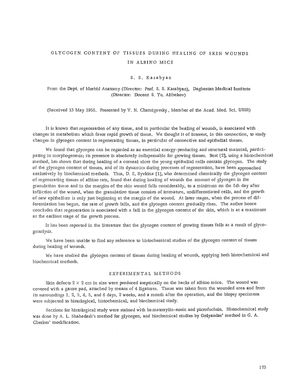Glycogen Content of Tissues During Healing of Skin Wounds in Albino Mice
February 1956
in “
Bulletin of Experimental Biology and Medicine
”

TLDR Glycogen levels in mouse skin drop after injury but increase during healing, returning to normal within a month.
The study investigated the glycogen content in tissues during the healing of skin wounds in albino mice, using both histochemical and biochemical methods. Skin defects were created on the mice, and tissue samples were taken at various intervals post-operation for analysis. The results showed that the glycogen content in the skin decreased to an average of 2 mg/g during the first three days after wounding, primarily due to the loss of hair follicles, which are a major glycogen depot. However, glycogen accumulation was observed in regenerating epithelium during this time. By the fourth day, the glycogen content began to increase, reaching an average of 10.5 mg/g by the sixth day, with the rise attributed to the regenerating epithelium and hair follicle epithelium. Two weeks post-wounding, the glycogen content returned to a normal average value of 7.9 mg/g, and one month after the wound, the glycogen content stabilized at an average of 7.8 mg/g, with the histochemical picture indicating a return to normal conditions. This study supports the idea that glycogen is essential for tissue growth during wound healing, with its content fluctuating in different stages of the healing process.